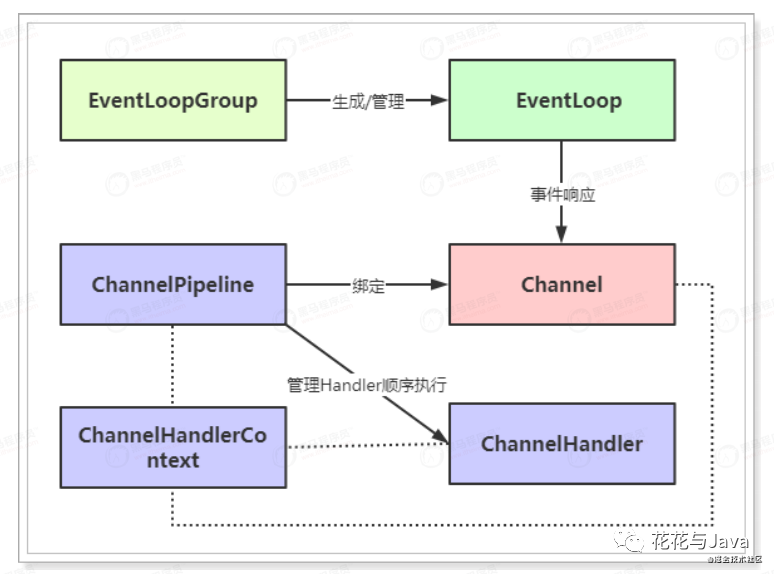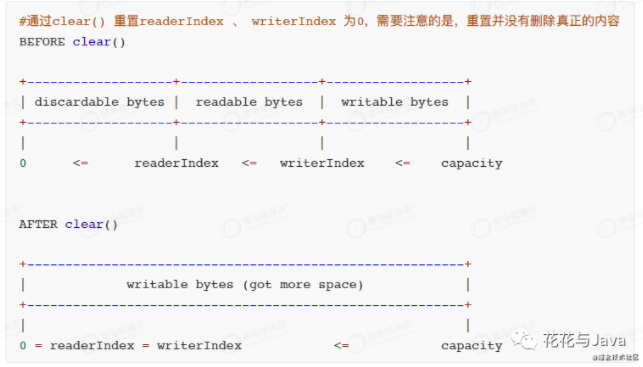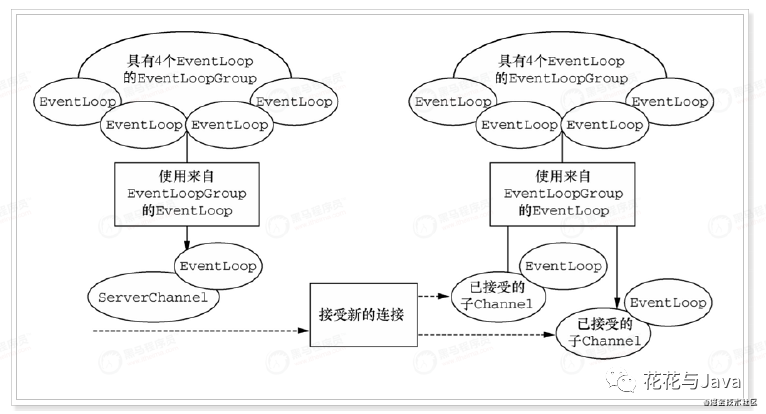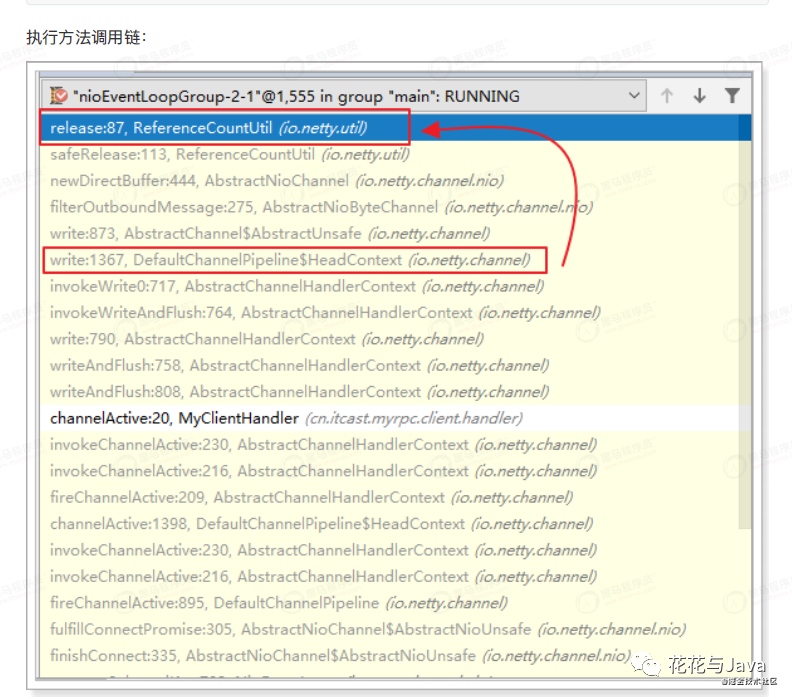上文对IO模型和Reactor模型进行讲解,是不是感觉有点懵懵的。哈哈哈,反正我并没有对其有深入见解。我是这样安慰自己的,知识在不断的反复学习和思考中有新的感悟。不气馁,继续新的征程。本篇文章想来从实战开始,带我深入了解Netty各个组件是做什么?ByteBuf执行原理又是怎样的?
01一 第一个Netty实例
用Netty实现通信。说白了就是客户端向服务端发消息,服务端接收消息并给客户端响应。所以我来看看服务端和客户端是如何实现的?
11.1 服务端
1. 依赖
- <?xml version="1.0" encoding="UTF-8"?>
- <project xmlns="http://maven.apache.org/POM/4.0.0"
- xmlns:xsi="http://www.w3.org/2001/XMLSchema-instance"
- xsi:schemaLocation="http://maven.apache.org/POM/4.0.0 http://maven.apache.org/xsd/maven-4.0.0.xsd">
- <modelVersion>4.0.0</modelVersion>
- <groupId>com.haopt.iot</groupId>
- <artifactId>first-netty</artifactId>
- <packaging>jar</packaging>
- <version>1.0-SNAPSHOT</version>
- <dependencies>
- <dependency>
- <groupId>io.netty</groupId>
- <artifactId>netty-all</artifactId>
- <version>4.1.50.Final</version>
- </dependency>
- <dependency>
- <groupId>junit</groupId>
- <artifactId>junit</artifactId>
- <version>4.12</version>
- </dependency>
- </dependencies>
- <build>
- <plugins>
- <plugin>
- <groupId>org.apache.maven.plugins</groupId>
- <artifactId>maven-compiler-plugin</artifactId>
- <version>3.2</version>
- <configuration>
- <source>1.8</source>
- <target>1.8</target>
- <encoding>UTF-8</encoding>
- </configuration>
- </plugin>
- </plugins>
- </build>
- </project>
2. 服务端-MyRPCServer
- package com.haopt.netty.server;
- import io.netty.bootstrap.ServerBootstrap;
- import io.netty.buffer.UnpooledByteBufAllocator;
- import io.netty.channel.ChannelFuture;
- import io.netty.channel.ChannelOption;
- import io.netty.channel.EventLoopGroup;
- import io.netty.channel.nio.NioEventLoopGroup;
- import io.netty.channel.socket.nio.NioServerSocketChannel;
- public class MyRPCServer {
- public void start(int port) throws Exception {
- // 主线程,不处理任何业务逻辑,只是接收客户的连接请求
- EventLoopGroup boss = new NioEventLoopGroup(1);
- // 工作线程,线程数默认是:cpu核数*2
- EventLoopGroup worker = new NioEventLoopGroup();
- try {
- // 服务器启动类
- ServerBootstrap serverBootstrap = new ServerBootstrap();
- serverBootstrap.group(boss, worker) //设置线程组
- .channel(NioServerSocketChannel.class) //配置server通道
- .childHandler(new MyChannelInitializer()); //worker线程的处理器
- //ByteBuf 的分配要设置为非池化,否则不能切换到堆缓冲区模式
- serverBootstrap.childOption(ChannelOption.ALLOCATOR, UnpooledByteBufAllocator.DEFAULT);
- ChannelFuture future = serverBootstrap.bind(port).sync();
- System.out.println("服务器启动完成,端口为:" + port);
- //等待服务端监听端口关闭
- future.channel().closeFuture().sync();
- } finally {
- //优雅关闭
- boss.shutdownGracefully();
- worker.shutdownGracefully();
- }
- }
- }
3. 服务端-ChannelHandler
- package com.haopt.netty.server.handler;
- import io.netty.buffer.ByteBuf;
- import io.netty.buffer.Unpooled;
- import io.netty.channel.ChannelHandlerContext;
- import io.netty.channel.ChannelInboundHandlerAdapter;
- import io.netty.util.CharsetUtil;
- public class MyChannelHandler extends ChannelInboundHandlerAdapter {
- /**
- * 获取客户端发来的数据
- * @param ctx
- * @param msg
- * @throws Exception
- */
- @Override
- public void channelRead(ChannelHandlerContext ctx, Object msg) throws Exception {
- ByteBuf byteBuf = (ByteBuf) msg;
- String msgStr = byteBuf.toString(CharsetUtil.UTF_8);
- System.out.println("客户端发来数据:" + msgStr);
- //向客户端发送数据
- ctx.writeAndFlush(Unpooled.copiedBuffer("ok", CharsetUtil.UTF_8));
- }
- /**
- * 异常处理
- * @param ctx
- * @param cause
- * @throws Exception
- */
- @Override
- public void exceptionCaught(ChannelHandlerContext ctx, Throwable cause) throws Exception {
- cause.printStackTrace();
- ctx.close();
- }
- }
4. 测试用例
- package com.haopt.netty.myrpc;
- import com.haopt.netty.server.MyRPCServer;
- import org.junit.Test;
- public class TestServer {
- @Test
- public void testServer() throws Exception{
- MyRPCServer myRPCServer = new MyRPCServer();
- myRPCServer.start(5566);
- }
- }
21.2 客户端
1. 客户端-client
- package com.haopt.netty.client;
- import com.haopt.netty.client.handler.MyClientHandler;
- import io.netty.bootstrap.Bootstrap;
- import io.netty.channel.ChannelFuture;
- import io.netty.channel.EventLoopGroup;
- import io.netty.channel.nio.NioEventLoopGroup;
- import io.netty.channel.socket.nio.NioSocketChannel;
- public class MyRPCClient {
- public void start(String host, int port) throws Exception {
- //定义⼯作线程组
- EventLoopGroup worker = new NioEventLoopGroup();
- try {
- //注意:client使⽤的是Bootstrap
- Bootstrap bootstrap = new Bootstrap();
- bootstrap.group(worker)
- .channel(NioSocketChannel.class) //注意:client使⽤的是NioSocketChannel
- .handler(new MyClientHandler());
- //连接到远程服务
- ChannelFuture future = bootstrap.connect(host, port).sync();
- future.channel().closeFuture().sync();
- } finally {
- worker.shutdownGracefully();
- }
- }
- }
2. 客户端-(ClientHandler)
- package com.haopt.netty.client.handler;
- import io.netty.buffer.ByteBuf;
- import io.netty.buffer.Unpooled;
- import io.netty.channel.ChannelHandlerContext;
- import io.netty.channel.SimpleChannelInboundHandler;
- import io.netty.util.CharsetUtil;
- public class MyClientHandler extends SimpleChannelInboundHandler<ByteBuf> {
- @Override
- protected void channelRead0(ChannelHandlerContext ctx, ByteBuf msg) throws Exception {
- System.out.println("接收到服务端的消息:" +
- msg.toString(CharsetUtil.UTF_8));
- }
- @Override
- public void channelActive(ChannelHandlerContext ctx) throws Exception {
- // 向服务端发送数据
- String msg = "hello";
- ctx.writeAndFlush(Unpooled.copiedBuffer(msg, CharsetUtil.UTF_8));
- }
- @Override
- public void exceptionCaught(ChannelHandlerContext ctx, Throwable cause) throws Exception {
- cause.printStackTrace();
- ctx.close();
- }
- }
相信代码执行起来没有任何问题(如果有任何问题反应交流)。但是对上面代码为何这样实现有很多疑。嘿嘿,我也是奥。接下来我们对这些代码中用到的组件进行介绍,希望能消除之前疑虑。如果还是不能,可以把疑问写于留言处,嘿嘿,我也不一定会有个好的解答,但是大佬总会有的。
02二 Netty核心组件
我们都知道Netty是基于事件驱动。但是事件发生后,Netty的各个组件都做了什么?来看看下面内容!
3 2.1 Channel
1. 初识Channel
- a 可以理解为socket连接,客户端和服务端连接的时候会创建一个channel。
- 负责基本的IO操作,例如:bind()、connect()、read()、write()。
- b Netty的Channel接口所提供的API,大大减少了Socket类复杂性
2. 常见Channel(不同的协议和阻塞类型的连接会有不同的Channel类型与之对应)
- a NioSocketChannel,NIO的客户端 TCP Socket 连接。
- b NioServerSocketChannel,NIO的服务器端 TCP Socket 连接。
- c NioDatagramChannel, UDP 连接。
- d NioSctpChannel,客户端 Sctp 连接。
- e NioSctpServerChannel,Sctp 服务器端连接,这些通道涵盖了UDP和TCP⽹络IO以及⽂件IO。
4 2.2 EventLoopGroup、EventLoop
1. 概述
- 有了Channel连接服务,连接之间消息流动。服务器发出消息称为出站,服务器接受消息称为入站。
- 那么消息出站和入站就产生了事件例如:连接已激活;数据读取;用户事件;异常事件;打开连接;
- 关闭连接等等。有了事件,有了事件就需要机制来监控和协调事件,这个机制就是EventLoop。
2. 初识EventLoopGroup、EventLoop

对上图解释
- a 一个EventLoopGroup包含一个或者多个EventLoop
- b 一个EventLoop在生命周期内之和一个Thread绑定
- c EventLoop上所有的IO事件在它专有的Thread上被处理。
- d Channel在它生命周期只注册于一个Event Loop
- e 一个Event Loop可能被分配给一个或者多个Channel
3. 代码实现
- // 主线程,不处理任何业务逻辑,只是接收客户的连接请求
- EventLoopGroup boss = new NioEventLoopGroup(1);
- // ⼯作线程,线程数默认是:cpu*2
- EventLoopGroup worker = new NioEventLoopGroup();
5 2.3 ChannelHandler
1. 初识ChannelHandler
- 对于数据的出站和入栈的业务逻辑都是在ChannelHandler中。
2. 对于出站和入站对应的ChannelHandler

- ChannelInboundHandler ⼊站事件处理器
- ChannelOutBoundHandler 出站事件处理器
3. 开发中常用的ChannelHandler(ChannelInboundHandlerAdapter、SimpleChannelInboundHandler)
a 源码
b SimpleChannelInboundHandler的源码(是ChannelInboundHandlerAdapter子类)

注意:
两者的区别在于,前者不会释放消息数据的引⽤,⽽后者会释放消息数据的引⽤。
6 2.4 ChannelPipeline
1. 初识ChannelPipeline
- 将ChannelHandler串起来。一个Channel包含一个ChannelPipeline,而ChannelPipeline维护者一个ChannelHandler列表。
- ChannelHandler与Channel和ChannelPipeline之间的映射关系,由ChannelHandlerContext进⾏维护。
如上图解释
- ChannelHandler按照加⼊的顺序会组成⼀个双向链表,⼊站事件从链表的head往后传递到最后⼀个ChannelHandler。
- 出站事件从链表的tail向前传递,直到最后⼀个ChannelHandler,两种类型的ChannelHandler相互不会影响。
7 2.5 Bootstrap
1. 初识Bootstrap
- 是引导作用,配置整个netty程序,将各个组件串起来,最后绑定接口,启动服务。
2. Bootstrap两种类型(Bootstrap、ServerBootstrap)
- 客户端只需要一个EventLoopGroup,服务端需要两个EventLoopGroup。
上图解释
- 与ServerChannel相关联的EventLoopGroup 将分配⼀个负责为传⼊连接请求创建 Channel 的EventLoop。
- ⼀旦连接被接受,第⼆个 EventLoopGroup 就会给它的 Channel 分配⼀个 EventLoop。
8 2.6 Future
1. 初识
- 操作完成时通知应用程序的方式。这个对象可以看做异步操作执行结果占位符,它在将来某个时刻完成,并提供对其结果的访问。
2. ChannelFuture的由来
- JDK 预置了 interface java.util.concurrent.Future,但是其所提供的实现,
- 只允许⼿动检查对应的操作是否已经完成,或者⼀直阻塞直到它完成。这是⾮常
- 繁琐的,所以 Netty 提供了它⾃⼰的实现--ChannelFuture,⽤于在执⾏异步
- 操作的时候使⽤。
3. Netty为什么完全是异步?
- a ChannelFuture提供了⼏种额外的⽅法,这些⽅法使得我们能够注册⼀个或者多个 ChannelFutureListener实例。
- b 监听器的回调⽅法operationComplete(),将会在对应的操作完成时被调⽤。
- 然后监听器可以判断该操作是成功地完成了还是出错了。
- c 每个 Netty 的出站 I/O 操作都将返回⼀个 ChannelFuture,也就是说,
- 它们都不会阻塞。所以说,Netty完全是异步和事件驱动的。
9 2.7 组件小结

上图解释
- 将组件串起来
03三 缓存区-ByteBuf
ByteBuf是我们开发中代码操作最多部分和出现问题最多的一部分。比如常见的TCP协议通信的粘包和拆包解决,和ByteBuf密切相关。后面文章会详细分析,先不展开。我们这里先了解ByteBuf的常用API和执行内幕。
10 3.1 ByteBuf概述
1. 初识ByteBuf
- JavaNIO提供了缓存容器(ByteBuffer),但是使用复杂。因此netty引入缓存ButeBuf,
- 一串字节数组构成。
2. ByteBuf两个索引(readerIndex,writerIndex)
- a readerIndex 将会根据读取的字节数递增
- b writerIndex 也会根据写⼊的字节数进⾏递增
- 注意:如果readerIndex超过了writerIndex的时候,Netty会抛出IndexOutOf-BoundsException异常。
11 3.2 ByteBuf基本使用
1. 读取
- package com.haopt.netty.myrpc.test;
- import io.netty.buffer.ByteBuf;
- import io.netty.buffer.Unpooled;
- import io.netty.util.CharsetUtil;
- public class TestByteBuf01 {
- public static void main(String[] args) {
- //构造
- ByteBuf byteBuf = Unpooled.copiedBuffer("hello world",
- CharsetUtil.UTF_8);
- System.out.println("byteBuf的容量为:" + byteBuf.capacity());
- System.out.println("byteBuf的可读容量为:" + byteBuf.readableBytes());
- System.out.println("byteBuf的可写容量为:" + byteBuf.writableBytes());
- while (byteBuf.isReadable()){ //⽅法⼀:内部通过移动readerIndex进⾏读取
- System.out.println((char)byteBuf.readByte());
- }
- //⽅法⼆:通过下标直接读取
- for (int i = 0; i < byteBuf.readableBytes(); i++) {
- System.out.println((char)byteBuf.getByte(i));
- }
- //⽅法三:转化为byte[]进⾏读取
- byte[] bytes = byteBuf.array();
- for (byte b : bytes) {
- System.out.println((char)b);
- }
- }
- }
2. 写入
- package com.haopt.netty.myrpc.test;
- import io.netty.buffer.ByteBuf;
- import io.netty.buffer.Unpooled;
- import io.netty.util.CharsetUtil;
- public class TestByteBuf02 {
- public static void main(String[] args) {
- //构造空的字节缓冲区,初始⼤⼩为10,最⼤为20
- ByteBuf byteBuf = Unpooled.buffer(10,20);
- System.out.println("byteBuf的容量为:" + byteBuf.capacity());
- System.out.println("byteBuf的可读容量为:" + byteBuf.readableBytes());
- System.out.println("byteBuf的可写容量为:" + byteBuf.writableBytes());
- for (int i = 0; i < 5; i++) {
- byteBuf.writeInt(i); //写⼊int类型,⼀个int占4个字节
- }
- System.out.println("ok");
- System.out.println("byteBuf的容量为:" + byteBuf.capacity());
- System.out.println("byteBuf的可读容量为:" + byteBuf.readableBytes());
- System.out.println("byteBuf的可写容量为:" + byteBuf.writableBytes());
- while (byteBuf.isReadable()){
- System.out.println(byteBuf.readInt());
- }
- }
- }
3. 丢弃已读字节

- package com.haopt.netty.myrpc.test;
- import io.netty.buffer.ByteBuf;
- import io.netty.buffer.Unpooled;
- import io.netty.util.CharsetUtil;
- public class TestByteBuf03 {
- public static void main(String[] args) {
- ByteBuf byteBuf = Unpooled.copiedBuffer("hello world",CharsetUtil.UTF_8);
- System.out.println("byteBuf的容量为:" + byteBuf.capacity());
- System.out.println("byteBuf的可读容量为:" + byteBuf.readableBytes());
- System.out.println("byteBuf的可写容量为:" + byteBuf.writableBytes());
- while (byteBuf.isReadable()){
- System.out.println((char)byteBuf.readByte());
- }
- byteBuf.discardReadBytes(); //丢弃已读的字节空间
- System.out.println("byteBuf的容量为:" + byteBuf.capacity());
- System.out.println("byteBuf的可读容量为:" + byteBuf.readableBytes());
- System.out.println("byteBuf的可写容量为:" + byteBuf.writableBytes());
- }
4. clear()

- package com.haopt.netty.myrpc.test;
- import io.netty.buffer.ByteBuf;
- import io.netty.buffer.Unpooled;
- import io.netty.util.CharsetUtil;
- public class TestByteBuf04 {
- public static void main(String[] args) {
- ByteBuf byteBuf = Unpooled.copiedBuffer("hello world",CharsetUtil.UTF_8);
- System.out.println("byteBuf的容量为:" + byteBuf.capacity());
- System.out.println("byteBuf的可读容量为:" + byteBuf.readableBytes());
- System.out.println("byteBuf的可写容量为:" + byteBuf.writableBytes());
- byteBuf.clear(); //重置readerIndex 、 writerIndex 为0
- System.out.println("byteBuf的容量为:" + byteBuf.capacity());
- System.out.println("byteBuf的可读容量为:" + byteBuf.readableBytes());
- System.out.println("byteBuf的可写容量为:" + byteBuf.writableBytes());
- }
- }
12 3.3 ByteBuf 使⽤模式
3.3.1 根据存放缓冲区,分为三类
1. 堆缓存区(HeapByteBuf)
- 内存的分配和回收速度⽐较快,可以被JVM⾃动回收,缺点是,如果进⾏socket的IO读写,需要额外做⼀次内存复制,将堆内存对应的缓冲区复制到内核Channel中,性能会有⼀定程度的下降。
- 由于在堆上被 JVM 管理,在不被使⽤时可以快速释放。可以通过 ByteBuf.array() 来获取 byte[] 数
- 据。
2. 直接缓存区(DirectByteBuf)
- ⾮堆内存,它在对外进⾏内存分配,相⽐堆内存,它的分配和回收速度会慢⼀些,但是
- 将它写⼊或从Socket Channel中读取时,由于减少了⼀次内存拷⻉,速度⽐堆内存块。
3. 复合缓存区
- 顾名思义就是将上述两类缓冲区聚合在⼀起。Netty 提供了⼀个 CompsiteByteBuf,
- 可以将堆缓冲区和直接缓冲区的数据放在⼀起,让使⽤更加⽅便。
3.3.2 缓存区选择
Netty默认使⽤的是直接缓冲区(DirectByteBuf),如果需要使⽤堆缓冲区(HeapByteBuf)模式,则需要进⾏系统参数的设置。
- //netty中IO操作都是基于Unsafe完成的
- System.setProperty("io.netty.noUnsafe", "true");
- //ByteBuf的分配要设置为⾮池化,否则不能切换到堆缓冲器模式
- serverBootstrap.childOption(ChannelOption.ALLOCATOR,UnpooledByteBufAllocator.DEFAULT);
3.3.3 ByteBuf对象是否池化(Netty是默认池化的)
1. 池化化和非池化的实现
- PooledByteBufAllocator,实现了ByteBuf的对象的池化,提⾼性能减少并最⼤限度地减少内存碎⽚。
- UnpooledByteBufAllocator,没有实现对象的池化,每次会⽣成新的对象实例。
2. 代码实现(让Netty中ByteBuf对象不池化)
- //通过ChannelHandlerContext获取ByteBufAllocator实例
- ctx.alloc();
- //通过channel也可以获取
- channel.alloc();
- //Netty默认使⽤了PooledByteBufAllocator
- //可以在引导类中设置⾮池化模式
- serverBootstrap.childOption(ChannelOption.ALLOCATOR,UnpooledByteBufAllocator.DEFAULT);
- //或通过系统参数设置
- System.setProperty("io.netty.allocator.type", "pooled");
- System.setProperty("io.netty.allocator.type", "unpooled");
我在开发项目中,我一般不进行更改。因为我觉得池化效率更高。有其他高见,欢迎留言。
13 3.5 ByteBuf的释放
ByteBuf如果采⽤的是堆缓冲区模式的话,可以由GC回收,但是如果采⽤的是直接缓冲区,就不受GC的 管理,就得⼿动释放,否则会发⽣内存泄露。
3.5.1 ByteBuf的手动释放(一般不推荐使用,了解)
1. 实现逻辑
- ⼿动释放,就是在使⽤完成后,调⽤ReferenceCountUtil.release(byteBuf); 进⾏释放。
- 通过release⽅法减去 byteBuf的使⽤计数,Netty 会⾃动回收 byteBuf。
2. 代码
- /**
- * 获取客户端发来的数据
- *
- * @param ctx
- * @param msg
- * @throws Exception
- */
- @Override
- public void channelRead(ChannelHandlerContext ctx, Object msg) throws Exception {
- ByteBuf byteBuf = (ByteBuf) msg;
- String msgStr = byteBuf.toString(CharsetUtil.UTF_8);
- System.out.println("客户端发来数据:" + msgStr);
- //释放资源
- ReferenceCountUtil.release(byteBuf);
- }
注意:
⼿动释放可以达到⽬的,但是这种⽅式会⽐较繁琐,如果⼀旦忘记释放就可能会造成内存泄露。
3.5.1 ByteBuf的自动释放
⾃动释放有三种⽅式,分别是:⼊站的TailHandler、继承SimpleChannelInboundHandler、 HeadHandler的出站释放。
1. TailHandler
Netty的ChannelPipleline的流⽔线的末端是TailHandler,默认情况下如果每个⼊站处理器Handler都把消息往下传,TailHandler会释放掉ReferenceCounted类型的消息。
- /**
- * 获取客户端发来的数据
- * @param ctx
- * @param msg
- * @throws Exception
- */
- @Override
- public void channelRead(ChannelHandlerContext ctx, Object msg) throws Exception {
- ByteBuf byteBuf = (ByteBuf) msg;
- String msgStr = byteBuf.toString(CharsetUtil.UTF_8);
- System.out.println("客户端发来数据:" + msgStr);
- //向客户端发送数据
- ctx.writeAndFlush(Unpooled.copiedBuffer("ok", CharsetUtil.UTF_8));
- ctx.fireChannelRead(msg); //将ByteBuf向下传递
- }
源码:
在DefaultChannelPipeline中的TailContext内部类会在最后执⾏
- @Override
- public void channelRead(ChannelHandlerContext ctx, Object msg) {
- onUnhandledInboundMessage(ctx, msg);
- }
- //最后会执⾏
- protected void onUnhandledInboundMessage(Object msg) {
- try {
- logger.debug(
- "Discarded inbound message {} that reached at the tail of the
- pipeline. " + "Please check your pipeline configuration.", msg);
- } finally {
- ReferenceCountUtil.release(msg); //释放资源
- }
- }
2. SimpleChannelInboundHandler
当ChannelHandler继承了SimpleChannelInboundHandler后,在SimpleChannelInboundHandler的channelRead()⽅法中,将会进⾏资源的释放。
SimpleChannelInboundHandler的源码
- //SimpleChannelInboundHandler中的channelRead()
- @Override
- public void channelRead(ChannelHandlerContext ctx, Object msg) throws Exception {
- boolean release = true;
- try {
- if (acceptInboundMessage(msg)) {
- @SuppressWarnings("unchecked")
- I imsg = (I) msg;
- channelRead0(ctx, imsg);
- } else {
- release = false;
- ctx.fireChannelRead(msg);
- }
- } finally {
- if (autoRelease && release) {
- ReferenceCountUtil.release(msg); //在这⾥释放
- }
- }
- }
我们handler代码编写:
- package com.haopt.myrpc.client.handler;
- import io.netty.buffer.ByteBuf;
- import io.netty.buffer.Unpooled;
- import io.netty.channel.ChannelHandlerContext;
- import io.netty.channel.SimpleChannelInboundHandler;
- import io.netty.util.CharsetUtil;
- public class MyClientHandler extends SimpleChannelInboundHandler<ByteBuf> {
- @Override
- protected void channelRead0(ChannelHandlerContext ctx, ByteBuf msg) throws Exception {
- System.out.println("接收到服务端的消息:" +
- msg.toString(CharsetUtil.UTF_8));
- }
- @Override
- public void channelActive(ChannelHandlerContext ctx) throws Exception {
- // 向服务端发送数据
- String msg = "hello";
- ctx.writeAndFlush(Unpooled.copiedBuffer(msg, CharsetUtil.UTF_8));
- }
- @Override
- public void exceptionCaught(ChannelHandlerContext ctx, Throwable cause) throws Exception {
- cause.printStackTrace();
- ctx.close();
- }
- }
3. 堆缓冲区(HeadHandler)
出站处理流程中,申请分配到的ByteBuf,通过HeadHandler完成⾃动释放。
在出站流程开始的时候,通过调⽤ctx.writeAndFlush(msg),Bytebuf缓冲区开始进⼊出站处理的pipeline流⽔线。
在每⼀个出站Handler中的处理完成后,最后消息会来到出站的最后⼀棒HeadHandler,再经过⼀轮复杂的调⽤,在flush完成后终将被release掉。
- package com.haopt.myrpc.client.handler;
- import io.netty.buffer.ByteBuf;
- import io.netty.buffer.Unpooled;
- import io.netty.channel.ChannelHandlerContext;
- import io.netty.channel.SimpleChannelInboundHandler;
- import io.netty.util.CharsetUtil;
- public class MyClientHandler extends SimpleChannelInboundHandler<ByteBuf> {
- @Override
- protected void channelRead0(ChannelHandlerContext ctx, ByteBuf msg) throws
- Exception {
- System.out.println("接收到服务端的消息:" +
- msg.toString(CharsetUtil.UTF_8));
- }
- @Override
- public void channelActive(ChannelHandlerContext ctx) throws Exception {
- // 向服务端发送数据
- String msg = "hello";
- ctx.writeAndFlush(Unpooled.copiedBuffer(msg, CharsetUtil.UTF_8));
- }
- @Override
- public void exceptionCaught(ChannelHandlerContext ctx, Throwable cause)
- throws Exception {
- cause.printStackTrace();
- ctx.close();
- }
- }
14 3.6 ByteBuf小结
a ⼊站流程中,如果对原消息不做处理,调ctx.fireChannelRead(msg) 把
原消息往下传,由流⽔线最后⼀棒 TailHandler 完成⾃动释放。
b 如果截断了⼊站处理流⽔线,则继承SimpleChannelInboundHandler ,完成⼊站ByteBuf ⾃动释放。
c 出站处理过程中,申请分配到的 ByteBuf,通过 HeadHandler 完成⾃动释放。
d ⼊站处理中,如果将原消息转化为新的消息ctx.fireChannelRead(newMsg)往下传,那必须把原消息release掉。
e ⼊站处理中,如果已经不再调⽤ ctx.fireChannelRead(msg) 传递任何消息,也没有继承SimpleChannelInboundHandler 完成⾃动释放,那更要把原消息release掉。






































